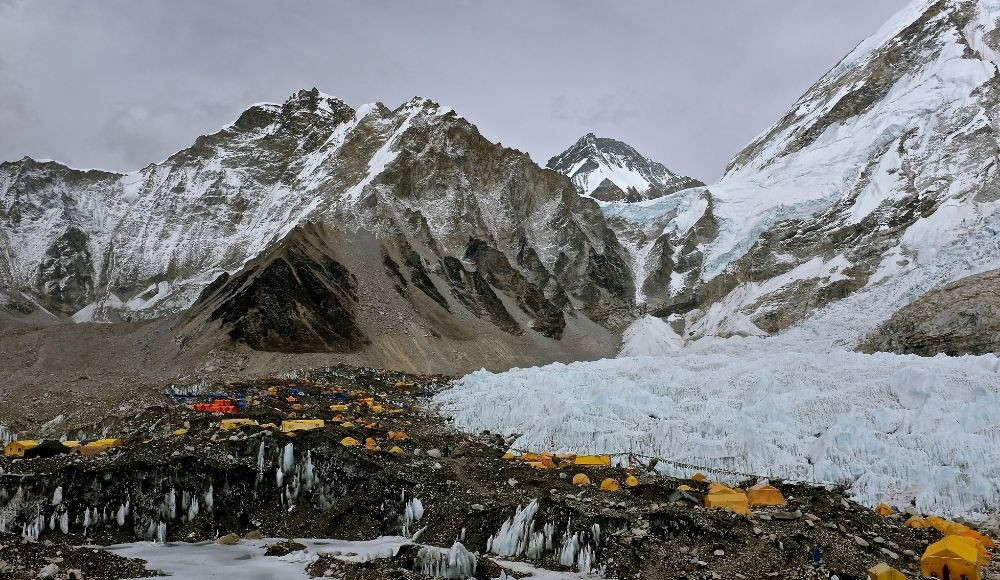How Long Does it Take to Climb Mount Everest
It is a significantly renowned trek all over the world because of the core adventure it offers and the vantage beauty it has from the top of the world.
It is a significantly renowned trek all over the world because of the core adventure it offers and the vantage beauty it has from the top of the world.


Everest Climbing is one of the highly desired activities of adventure enthusiasts. If you are willing to know how long does it take to climb Mount Everest, then stick with this write-up. You will get to know everything you need to understand before heading towards the Everest Climbing and Expedition.
Climbing Everest is a bucket list wish of many adventure lovers. It is a significantly renowned trek all over the world because of the core adventure it offers and the vantage beauty it has from the top of the world. Everest Base Camp Trek and Everest Expedition are popular among the high altitude trekkers and mountaineers. Trekking to Everest Base Camp is not only about the supreme adventure it has to offer but also about the beautiful insights on the lifestyle of Sherpas, hospitality and excellent natural beauty.
The expedition to Everest is a popular adventure and highly desired bucket list activity of adventure lovers. However, getting to the top of the world is not easy because of the new set of rules Nepal Government executed and the high altitude dangers of Everest itself.
Ever wondered about climbing Mount Everest? This article might help you to understand the days it takes to complete the Everest expedition and how long it takes to climb Everest in Nepal. The hardcore adventure requires very good stamina and fitness level as you will be gaining the height to the mountains on foot that a human can. Since Mount Everest is the highest point on earth, it is obviously the most difficult terrain you will ever reach on the planet. The altitude of Mount Everest is 8848 m above sea level and regarded as the highest peak in the world.
|
Trip Name |
Everest Expedition |
|
Main Season |
|
|
Guide Requirement for Everest Expedition |
|
|
Duration |
Minimum 60 Days Maximum 70 Days |
|
Required Permits |
|
|
Expedition Royalty for Normal Route |
|
|
Expedition Royalty for Other Route |
|
|
Available Transportation Mode |
|
|
Best Season for Everest Expedition |
Spring (March, April and May) |
Adventure lovers who are especially interested in trekking activities in the Himalayas are also interested in pursuing their high altitude trekking to the next level. Trekkers who are willing to understand how long does it take to climb Everest then, this article is for you. Climbing Everest is not an easy task. It requires a hardcore dedication integrated by physical fitness and huge adventure mindset. It requires acclimatization to cope with the high altitude in the Himalayas.
The climbing period might be short, but it takes a little longer since you have to prepare yourself for the high altitude at the top of the world. Acclimatization is the main reason it takes a longer time for Everest Climbing and to reach the top.
Depending upon the weather condition and acclimatization process, it generally takes around two months to complete the Everest Climbing Expedition. The Everest Expedition takes numerous acclimatization days and hardcore adventure to the summit of Mount Everest.
The total of 60 days is necessary to complete the Everest Expedition, however, physical fitness is necessary. Mount Everest is the riskiest mountain where many mountaineers lost their lives. The deadliest experience of Mount Everest is something unavoidable. Therefore, it is very necessary to acclimatize to complete the Everest summit expedition.
The Everest climbing expedition is completed on a few phases of acclimatization. Which is also known as acclimatization climbing. The acclimatization while climbing mount Everest involves a few steps in which climbers have to get back to the camp after getting to the high altitude.
Everest Base Camp itself requires acclimatization to cope with nearly 5300 m. altitude. Generally, the climber needs to acclimatize 5-6 days while making the climb to Khumbu Icefall from Everest Base Camp. Getting to the Khumbu Icefall is also the major difficulty of Everest climbing expeditions. But as per the recent Government regulation of Nepal, Climber needs to climb at least one mountain in Nepal to pursue climbing Mount Everest.
After getting to the Khumbu Icefall, the climber needs to descend to Base Camp for acclimatization. This will help climbers to cope with severe altitude problems they might face during the expedition. After returning to the base camp, the climber will have to get to the Camp I, and usually 2 days acclimatization is necessary at Camp I and again return back to the lowest Everest Base Camp.
After 3-4 days of acclimatization at Base Camp, the climber will have to ascend higher. Which involves getting to Camp I, and after one-day acclimatization there, further climb to Camp II. Camp II lies at the base of Lhotse. At Camp II, 2-3 days of acclimatization is necessary and again, the climber has to get back to the base camp.
The expedition then continues to Camp III. After getting to camp II again, and two days of acclimatization there, the climber will get to Camp III, and rest for one day there. The next morning, the climber will ascend to Camp IV. Camp IV is a very crucial part of the expedition. The climber may require additional oxygen to make the body stable and breathing smooth. The further climb will take us to the top of the world and the summit of Mount Everest.
Usually, getting to the top of Everest starts at midnight and early morning, since the trekker will get sufficient time to return to Camp IV. After completing the climb to the summit, Climber will get back to Camp III, Camp II and Camp I, finally getting to the base camp.
The returning process from the summit also involves some resting period at different camps. Which also helps to cope with the changing altitude and regain the adaptation to lower altitude. The Acclimatization period is the most important period during the expedition. Not only vital, but it is also a time-consuming process of the entire expedition.
|
Day 01 : Kathmandu Arrival |
|
Day 02 : Kathmandu Full Day Sightseeing. |
|
Day 03 : Trip Preparation |
|
Day 04 : Official briefing in the Ministry of Tourism. |
|
Day 05 : Fly to Lukla and trek to Phakding (2640m). |
|
Day 06 : Trek from Phakding to Namche Bazaar (3446m). |
|
Day 07 : Acclimatization at Namche Bazaar |
|
Day 08 : Trek from Namche Bazaar to Tengboche (3800m). |
|
Day 09 : Trek from Tengboche to Pheriche (4243m) |
|
Day 10 : Trek from Pheriche to Lobuche (4930m) |
|
Day 11 : Trek to Everest Base Camp (5360m) |
|
Day 12-60 : Climbing Period Mt. Everest (8848 m) |
|
Day 61 : Everest Base Camp to Pheriche |
|
Day 62 : Pheriche to Namche Bazaar |
|
Day 63 : Namche Bazaar to Lukla |
|
Day 64 : Lukla to Kathmandu |
|
Day 65 : Free time in Kathmandu |
|
Day 66 : Final Departure |
The prior experience of climbing is necessary to climb Mount Everest. To avoid the death toll in Mount Everest because of altitude sickness, exhaustion, and heart attacks, this new rule to climb Everest is in implementation. Which will eventually be beneficial to climbers to avoid the altitude problems and mountaineering experience will help in the difficult terrains of Mount Everest.
High altitude safety is a major concern in Nepal. The death count on Everest is not under control because of the lacking factors in climbers and inexperienced high altitude trekking in the Himalayas. For the dangerous consequences and sustainability, the government of Nepal sets a new rule to climb Everest.
As per the new rule in 2019, anybody who is willing to climb needs to have prior mountaineering experience and also have to climb at least one mountain above 6500 m. in Nepal before obtaining a permit. To control the aggravating condition of Mount Everest Climbing in Nepal, this new provision is expected to be helpful.
During 1956, after a huge effort and continuous dedication, a trigonometric survey was carried out. It was then known as peak XV and anticipated to be the highest mountain in the world. The surveyor-general Andrew Waugh proclaimed it to be the highest peak with an elevation of 29002 ft. Later the calculations were made for precision and the height was announced as 29,029 ft (8848 m).
In 2020, after years of debate, China and Nepal both agreed to measure the precise height of Mount Everest. The new agreed height of Mount Everest between both the countries, after measuring the elevation from both sides, is 8,848.86 meters (29,031.69 feet).The main reason that makes it so long to complete the climbing expedition to Mount Everest is acclimatization. The thin air and lower level of oxygen in the higher elevation of the mountain can be lethal and life-threatening. So, having good gears and enough acclimatization to cope with the oxygen level is very important.
The climbers spend more than two weeks acclimatizing to the climate and wait for good weather conditions. Then after following the protocols and the extensive guiding of Sherpas, the mountaineers move forth to brave the world’s highest peak.
Many Everest climbers spend months, in some cases, even years, practising and completing the rigorous training to climb Everest.
Mount Everest is full of myths and some pleasant and some disheartening facts. Many people have lost their lives trying to brave this mighty peak. Some of the interesting facts about Everest are:-
There are various names for Everest. Mount Everest is also known as Chomolungma or Qomolangma which means Goddess Mother of Mountains. The Nepali name is Sagarmatha which means forehead in the sky.
Mount Everest is situated between Nepal and Tibet. Tibet lies in the northern side and Nepal lies in the southern part.
The new agreed height of Mount Everest is 8848.86 Meters. Nepali and Chinese team measured it and agreed upon the new height of Mount Everest.
Sir Edmund Hillary submitted to Mount Everest for the first time.
It takes at least 40 days to reach the summit of Mount Everest.
Junko Tanabe was the first woman to climb Mount Everest.
There are up to 18 routes to climb Mount Everest.
As of 2020, more than 7000 people have climbed Everest.
Mount Everest is not the tallest mountain on the Earth if the measurement is made from the surface level. It is the tallest because the height is measured from sea level.
Everest is said to have been created 60 million years ago.
Climbing Mount Everest is a rigorous process. It requires climbing up and down during the whole process to acclimatize with the oxygen level. The descending process depends upon various circumstances that might occur on the trail.
Also, the oxygen deprivation and pace of walking up in the mountains affects the entire climbing process. The descending process is comparatively easier as you will be able to adapt to the new climate without having to stay for acclimatization. However, staying at different camps is preferred even during the descending time.